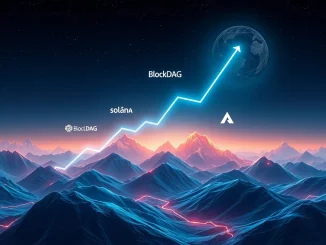
Is the crypto market as transparent as we believe? A chilling warning has been issued by a prominent voice in the crypto space, raising serious questions about the integrity of digital asset pricing. Arthur Cheong, the founder and CIO of DeFiance Capital, a well-respected crypto investment firm, has sounded the alarm regarding potential crypto price manipulation within the seemingly liquid cryptocurrency market. His concerns, voiced on X (formerly Twitter), highlight a lack of transparency that could have significant repercussions for investors, particularly in the volatile altcoin market.
Is Your Portfolio at Risk? DeFiance Capital’s Stark Warning on Crypto Price Manipulation
Cheong’s statement cuts to the heart of a growing unease within the crypto community. He alleges that certain projects and market makers may be engaging in practices that artificially inflate or sustain cryptocurrency prices. This is not just about market fluctuations; it’s about the potential for deliberate actions that mislead investors and distort the true value of digital assets. Let’s break down the key points of Cheong’s alarming message:
- Lack of Transparency: Cheong emphasizes the core issue – a critical lack of transparency in the liquid crypto market. This opacity makes it difficult to discern genuine market activity from artificial price movements.
- Allegations of Artificial Price Support: He suggests that some projects and market makers might be actively working to prop up prices, creating a false sense of market health.
- Centralized Exchange Inaction: A significant part of Cheong’s criticism is directed at centralized exchanges (CEXs). He accuses them of turning a blind eye to these potentially manipulative practices, failing to safeguard the interests of their users.
- Altcoin Price Performance Post-TGE: Cheong points to the stark reality of many altcoins after their Token Generation Events (TGEs). He notes a disturbing trend: a significant price drop of 70-90% within mere months of launch for numerous altcoins. This raises serious questions about the sustainability and genuine demand for these assets.
- Uninvestable Market Segment: The culmination of these issues leads to a grim prediction. Cheong warns that if the industry fails to address these transparency and manipulation concerns, a substantial portion of the crypto market could become effectively uninvestable. This is a severe indictment, suggesting a potential erosion of trust and capital flight from the sector.

The Shadowy Side of the Altcoin Market: Understanding the Concerns
The altcoin market, known for its high volatility and potential for explosive growth, is also often considered riskier than established cryptocurrencies like Bitcoin or Ethereum. Cheong’s warning adds another layer of complexity to this risk profile. Why is the altcoin market particularly vulnerable to price manipulation, and what are the potential implications?
- Lower Liquidity: Compared to major cryptocurrencies, many altcoins have lower trading volumes and liquidity. This makes them more susceptible to price swings and manipulation, as smaller trades can have a disproportionate impact on price.
- Project Hype vs. Fundamentals: The altcoin space is often driven by hype and narratives, sometimes overshadowing the underlying fundamentals and real-world utility of projects. This can create inflated valuations that are not sustainable.
- Market Maker Influence: Market makers play a crucial role in providing liquidity on exchanges. However, in less regulated or transparent markets, there’s a risk that some market makers may engage in practices that benefit themselves at the expense of other traders.
- Post-TGE Price Declines – A Red Flag?: The consistent pattern of significant price drops in altcoins after TGEs, as highlighted by Cheong, is indeed a cause for concern. It suggests that initial hype may be unsustainable, and perhaps, in some cases, artificially driven.
DeFi and Market Transparency: Is Decentralization the Answer?
While Cheong’s warning focuses on the broader crypto market, the concept of DeFi (Decentralized Finance) is inherently linked to the idea of greater transparency and reduced reliance on intermediaries. Does DeFi offer a potential solution to the issues raised by DeFiance Capital’s CIO?
Let’s consider the potential of DeFi to address market transparency concerns:
| Feature | Centralized Exchanges (CEXs) | Decentralized Exchanges (DEXs) |
|---|---|---|
| Transparency of Operations | Limited. Order books and trading activity are largely opaque. | Higher. Transactions are recorded on public blockchains, offering greater visibility. |
| Custody of Funds | Users entrust funds to the exchange. | Users retain control of their funds through self-custody wallets. |
| Market Manipulation Risks | Potentially higher due to centralized control and less transparency. | Potentially lower due to decentralized nature and on-chain transparency, though not entirely eliminated. |
| Regulatory Oversight | Subject to regulatory scrutiny, but enforcement can be challenging. | Regulatory landscape is still evolving and presents unique challenges. |
While DeFi aims for greater market transparency through blockchain technology, it’s not a silver bullet. DEXs, while offering more on-chain visibility, are not immune to manipulation. Front-running, sandwich attacks, and other forms of exploitation can still occur. Furthermore, the complexity of DeFi protocols can be a barrier to entry for many users, and smart contract risks are a constant concern.
Arthur Cheong’s Crypto Market Insights: What Actions Can Be Taken?
Cheong’s warning isn’t just about highlighting problems; it’s a call for action. What steps can be taken by the crypto industry, regulators, and investors to mitigate the risks of crypto price manipulation and enhance market integrity?
Here are some potential actionable insights:
- Increased Regulatory Scrutiny: Regulators need to step up their efforts to understand and oversee the crypto market. Clearer guidelines and enforcement actions against manipulative practices are crucial.
- Enhanced Exchange Transparency: Centralized exchanges should be pushed to improve their transparency. This could include more detailed reporting on trading activity, order book data, and measures taken to detect and prevent manipulation.
- Industry Self-Regulation: Crypto industry participants themselves have a responsibility to promote ethical practices and transparency. Industry bodies and associations can play a role in developing and enforcing standards.
- Investor Education: Investors need to be more aware of the risks associated with crypto, particularly altcoins, and understand the potential for price manipulation. Due diligence and critical evaluation of projects are essential.
- Technological Solutions: Exploring technological solutions to enhance market transparency and detect manipulation is important. On-chain analytics, surveillance tools, and decentralized audit mechanisms could play a role.
Conclusion: A Critical Juncture for Crypto Market Integrity
Arthur Cheong’s stark warning serves as a critical wake-up call for the crypto industry. The allegations of crypto price manipulation and the evident lack of market transparency are serious issues that demand immediate attention. The long-term health and sustainability of the crypto market depend on building trust and ensuring fair and transparent trading environments. Ignoring these concerns risks alienating investors and hindering the potential of blockchain technology. The industry is at a crossroads, and decisive action is needed to address these challenges and safeguard the future of crypto.



